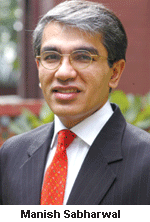 Most people (policy makers, parents, individuals, etc) intuitively agree that education is a journey to a better life. But most people don’t readily acknowledge the close connection between education, employability and employment. Yet if India aspires to reduce poverty, create equality of opportunity, and narrow the income gap between rich and poor, it must boldly take on vested interests in our current employment, employability and education (3E) regime, because India’s poverty is far from being the social equivalent of the HIN1 virus (for which we don’t know the cure).
Most people (policy makers, parents, individuals, etc) intuitively agree that education is a journey to a better life. But most people don’t readily acknowledge the close connection between education, employability and employment. Yet if India aspires to reduce poverty, create equality of opportunity, and narrow the income gap between rich and poor, it must boldly take on vested interests in our current employment, employability and education (3E) regime, because India’s poverty is far from being the social equivalent of the HIN1 virus (for which we don’t know the cure).
Most Indians have a pet personal explanation for the country’s pervasive poverty: climate, caste system, too much/too little government, too many/too few subsidies, corruption, Mughal invasions, British rule etc. I’d like to make the case that the incidence of deep poverty is highly correlated with illiteracy, farm jobs, the informal sector, rural areas and self-employment. Putting poverty in the museum necessitates changing the profile of India’s workforce by educating and skilling it.
Unfortunately, most politi-cians don’t believe reforming India’s 3E regime is good politics. But the current econo-mic downturn has created a constituency that has tasted or seen up close the benefits of non-farm, organised employ-ment and is now locked out because of layoffs (employees have gone from walking arou-nd with resignation letters in their pockets to wearing a helmet and hiding under their desks), tougher hiring stand-ards, and lower demand.
However the rot in our 3E regime predates this crisis. A graduate at a Jodhpur job mela told me he had completed his BA English programme in Hindi (because his teachers spoke only Hindi). An ITI administrator searches for a 220V DC fan in every inspection because it was demoed in his electrician diploma course (even though DC has not been used in India for 40 years). Twenty-five percent of government school teachers don’t show up in school everyday (despite being better paid than private school teachers). A car mechanic cannot be certified by an ITI unless he knows about a carburetor (though no contem-porary Indian car contains one). Some graduates of India’s 1,100 B-schools certified by AICTE cannot read and write (I have interviewed one), yet AICTE doesn’t ‘recognise’ the state-of-the-art Indian School of Business, Hyderabad (ranked among the world’s top 20 B-schools).
I could go on, but essentially the output of our 3E regime is not work ready. At best India’s youth have had their future altered; at worst they have lost it. Why? The best explanation comes from the world of medicine which identifies iatrogenic risks i.e the study of doctors putting patients at risk. Contemporary India’s 3E regime hurts the very children it is supposed to educate and empower.
To rectify this situation, policy makers need to attack the three labour market problems of matching (connecting supply with demand), mismatch (repairing supply for demand), and pipelining (preparing supply for demand). Matching requires converting employment exchanges into career centres (offering assessment, counseling, apprentice-ship, certification and jobs). It necessitates review of labour laws that encourage unorganised sector employment.
The mismatch problem (employability) needs incentivising states to establish skills missions (since they control delivery systems) and revamping the Apprentice Act which sabotages “learning by doing” and “learning while earning”. It must mutate the 100 days per year National Rural Employment Guarantee Scheme into a skills development programme.
The pipelining or preparatory programme (education) is regulatory. It requires teacher performance management, decentralisation, autonomy and governance. It also requires creation of a credible national qualification framework that creates fungibility between school, higher education and jobs. The most powerful theme across all three labour market constraints and education in particular, is performance management and linking financing to outcomes — because money spent is not necessarily money invested.
The 3E reform agenda proposed above offers huge benefits. It could reduce the percentage of people living in poverty from the current 50 percent to 5 percent in 20 years and save another 162 million from sliding into poverty. To paraphrase US President Barrack Obama, too many people in India argue that poverty cannot be eliminated — that we are destined to live in a nation in which 300 million people cannot read the newspaper they deliver, sit in automobiles they clean or send their children to schools they build.
Such fatalism is deadly. If we accept inability to rebuild our 3E regime, it’s an admission that pervasive poverty is inevitable. Therefore government and society need to affirm with conviction and commitment, a national determination to rebuild our 3E regime and conquer poverty. Although we must entertain no illusions, this goal can be reached quickly, and reached in our lifetimes.
This great and worthy endeavour will require great patience and persistence. We need to be determined to give every Indian the right to rise in life.
(Manish Sabharwal is the Bangalore-based chairman of Teamlease Services)